PBN Building Checklist (with Download)
Join the 1,000+ brands that trust us for their link building.
In this series, we reply to questions from members of our Facebook Group, SEO Round Table, with video responses in an effort to help them become stronger, more capable SEOs.
If you’d prefer to watch the video – click here or scroll to the end of the article.
Or if you’d like to skip the article and just get your hands on our downloadable PBN Checklist, just subscribe below.
PBN Checklist Introduction
Hey, guys. Nick here with another episode of Office Hours at the SirLinksalot Studios, and today I wanted to talk to you all about building a PBN out after you’ve already procured the actual domain.
PBN building was one of the first things that I got into when I started SEO, and I just really loved the fact that you were acting like an archaeologist going through old data and finding a way to repurpose it in a way that would be beneficial to a money site or something similar.
I wanted to give, especially to beginners, a template on how to go about building your first PBN – what to look for, what to do, and simple steps to follow to start building a PBN.
If you’re a little bit more advanced and looking for archived rebuilds or something like that, this might not be the best guide. However, a refresher could be useful, or you might even find something interesting that you don’t implement on your current PBN builds.
When you first start out, if you’re not using a PBN building service, you might be taking a little bit of extra time when it comes to your builds. But once you get in the swing of things and you understand where everything is at and the basic moving parts of a PBN, you’ll be able to come in and execute this task list in under an hour (or even 30 minutes).
Website Hosting, WordPress, and Organization
WordPress is where we’re going to focus on this PBN checklist. I know there are other ways to build PBNs, but we’re not going to talk about them now – this is a beginner’s guide. WordPress is the best and easiest site builder for most SEOs.
WordPress is very easy to use, and it’s easy to execute quick tasks and amass a lot of differentiation across a lot of different sites (PBNs) very easily.
After you’ve purchased a PBN domain, you’re going to host the site (see: best PBN hosting) and then set up WordPress.
If you’re not sure how to get a site hosted or install WordPress, a quick Google or Youtube search will get you sorted out easily.
After your site is hosted, you’re going to want to make sure that either your registrant info is set to private or some other information.
We recommend using a mix of privacy as well as personas. Having privacy on all your PBNs or using the same persona for everyone will create footprints.
You never want to have the same name across any PBNs, especially if they’re going to the same money sites. The idea is to create a footprint-free scenario that’s not going to be traceable by Google. So make sure your registrant info is diversified.
One way to create personas is to ask your neighbors, friends, or coworkers. But if you don’t want to do that, a quick Google search for something like “fake name generator” could be useful. This is against ICANN policy, but some people do use this… *wink*
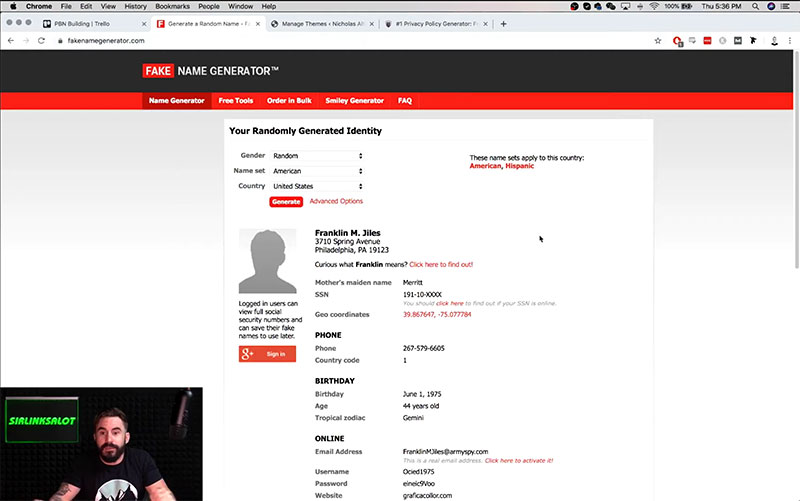
So you’d set it to random, and then whatever the TLD of your domain is is typically how you’d go about choosing the name and then the country that the persona is in.
One thing to note is that these addresses are fairly faulty, so it’s always good to make sure that it’s using an actual address.
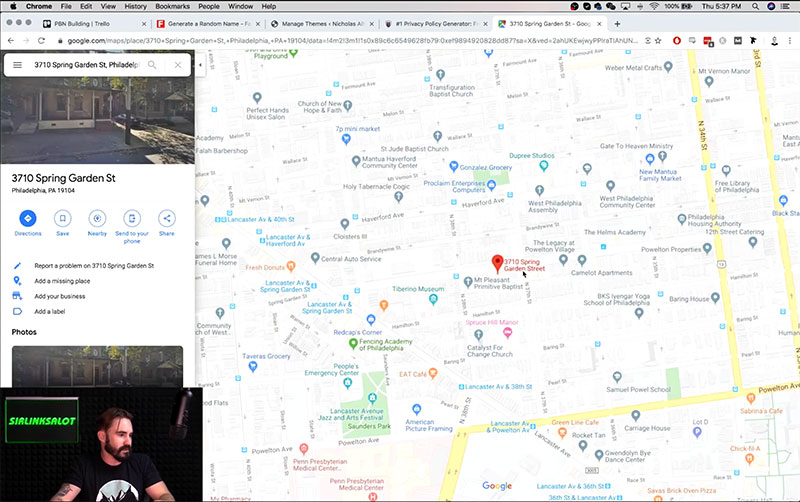
This one happens to be, but if it’s not I’ve heard you can go into Google Maps, find a building with no information, and then go ahead and pull the address from it. But again, that’s against ICANN policy – use it at your own risk.
Next, If you’re building a lot of PBNs to where you’ve got intentions of automating this process through a virtual assistant at some point in time, then it’s probably a good idea to get on a management platform like Trello, Quip, or Airtable.
One example is Trello. To start, you can add lists such as start, progress, and complete.
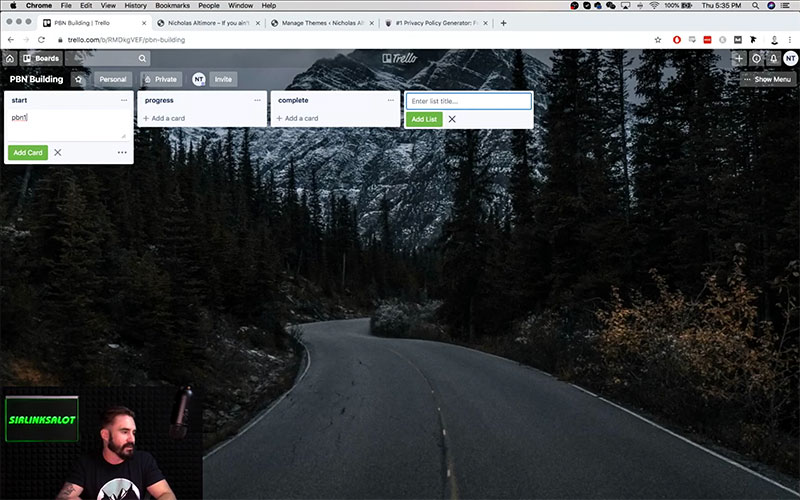
This is going to give you a management template that’s very easy to use.
It doesn’t take a whole lot of work, and it helps keep track of everything especially if you’re not doing everything in one day or if you’re working on big projects that are automated through virtual assistants.
Research, Rebuild, and Add to Your PBN
The next step is to research, rebuild and add things to this WordPress website.
First, remove sample pages and posts. Right now I’m just going to use nickaltimore.com, which literally has nothing on it, as an example. There aren’t any backlinks, and it’s not going to be used as a PBN – this is purely for example purposes.
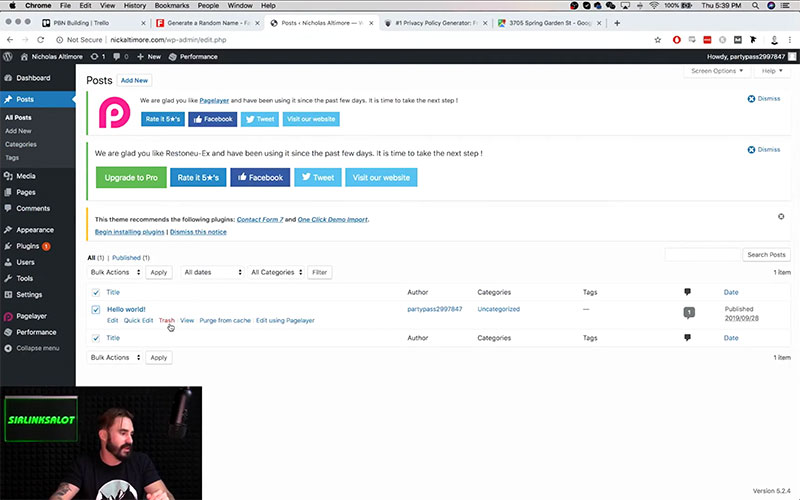
To remove posts and pages, you just go to either the post section or pages section. You’re going to click on this “Hello world” stuff and trash them. We’re doing that for all the pages and posts so that there’s nothing there.
Next, you’re going to research what niche your domain is in if you don’t know already. You’re going to do that by combing through the backlinks and anchors in Ahrefs, and maybe even pulling up the site in archive.org and looking up a historical version of the site.
If you need more specifics on how to do these things (including the archive check), check out our tutorial on how to use Ahrefs.
In Ahrefs you’re going to look at the top pages by links. You do this because, for example, let’s say you’ve got an expired domain and you’re trying to repurpose the juice that used to go to a specific page on this site. You don’t want that to just 404 and disappear. You’re trying to keep as much of that flowing to this new PBN as possible.
So you’re going to do that by looking up which articles had the most links going to them and rebuilding those pages within your own site as posts.
We do these as posts because we’re going to set it up to show on the homepage and let them go through the natural progression of being posted first on the homepage and then rolling off to inner pages as time and posts continue to accumulate.
You can get content from somewhere like iWriter which I’m sure the vast majority of you guys are familiar with. You can use the cheap content, just make sure that it’s going to pass Copyscape and that even though it’s a little bit rough, it’s not plagiarized as this can definitely affect things negatively.
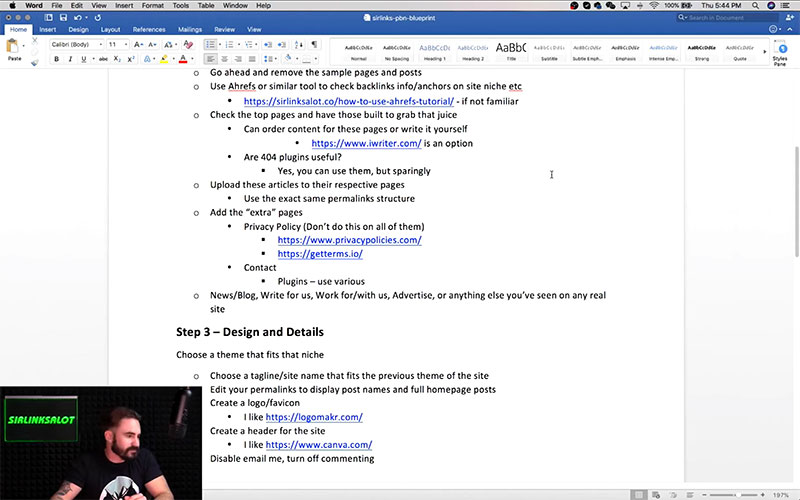
As for plugins, 404 plugins can be good for sites that have lots of pages with tons of links going to every inner page. If you don’t have the resources to rebuild every single one of those pages, 404 plugins can be used.
However, you want to use them sparingly. If you’ve got a network of 10 sites, don’t put 404 plugins on 50% or more of the network. You’re going to want to diversify.
Ultimately, I’ve found that the best medicine or best recourse of action is to find PBNs that have the majority of their links going to the homepage or just a few pages that you can rebuild the exact same permalink structure and get similar content.
But, yes, 404 plug-ins can be used. They’re not an absolute “no-no” that everybody says that you should completely stay away from. Building a PBN is about staying natural, so it’s natural for certain sites to use a plug-in like that since they are used on real sites as well.
Now, upload your articles to their respective pages. Make sure that you’re using the exact same permalink structure.
So let’s say that the website was nickaltimore.com. I looked up the backlinks and nickaltimore.com/super-mega-handsome had 10 million links going to it. Rebuild that page exactly as it is, add content pertinent to exactly what that page was about, and that page is going to pass juice to you and affect the overall power of the PBN itself.
Then, add extra pages. These would be things like privacy policy and contact pages. I’ve included a couple of links to privacy policies in the PBN checklist for you.
You don’t want to use the same privacy policy on all your PBNs. You might even want to use something like a spinner to spin the content. I don’t personally like to do that, but it is an option that people use. Again, gauge how hard you’re spinning this content and how legible or illegible it might be. Things like that will affect the power of your PBN.
Don’t overthink it, the point is to just push power. If you’ve got 10 PBNs or you’re starting off with building 5 this way – fine, put a privacy policy on two or three of them. Just make sure you generate them from different places and that they’re substantially different every time.
For the contact pages, you can use a plugin. Type “contact” into the plugins area.
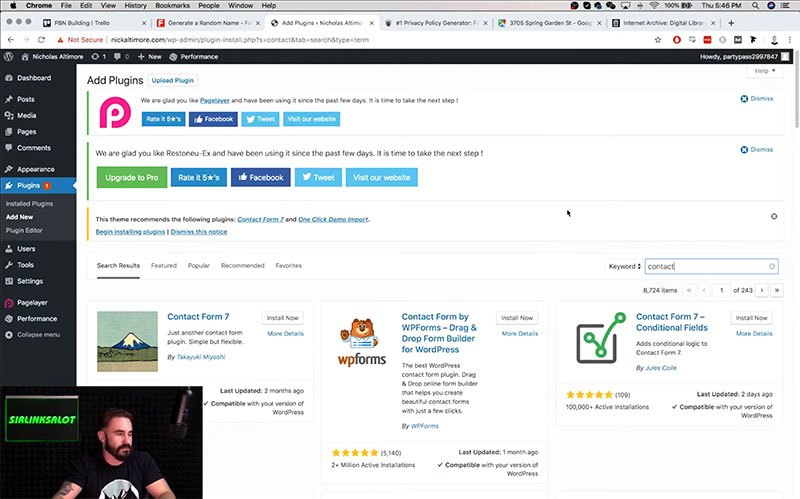
You’re going to have a bunch of different options. Find a free one, and then you can just use it as a contact page.
Almost every website out there has a contact page. If you over-saturate this in a PBN, it’s not an issue. However, if you use the exact same one over and over again, at some point it could become a footprint for you.
Be mindful of the fact that you want to diversify – especially as you grow out your PBN network. Five to ten PBNs are very easy to diversify. When you’re talking about 500 to a thousand PBNs or more… things start to get a little bit trickier.
Then, you can go ahead and add things like the news, blog page, write for us, work with us, advertise with us, or anything else you might see on a real site. These are going to make good additions to menus that make the site look natural, add content, add relevance, and overall just build up the authority of the PBN.
Site Design and Details
I know some people that don’t bother with design at all on a PBN – they just have bare-bones everything, they barely add images, etc. I stay away from that now because manual reviews do happen.
The more realistic your site looks (which doesn’t really take that much more effort), the better chances you’re going to have of not getting a de-index should you get a manual review of your PBN.
First off, choose a theme that’s going to fit the niche of your site. That’s pretty easy to do, however, not all themes are created equal, some are a little bit buggier than others, and some are trickier than others.
It’s good to get a set of 10-20 themes you like as you advance through PBN building, but for now and keeping it simple, we’ll just go to themes under appearance.
I have a restaurant tour one currently, and I’m not even good at cooking. We’ll just go with 2016, something generic. So I’m going to activate it and we’re good to go.
Next, you’re going to want to choose the tagline, the name of the site, and everything that a normal site would have. For a lot of these, you’ll be able to find out how to customize the site under the customize section.
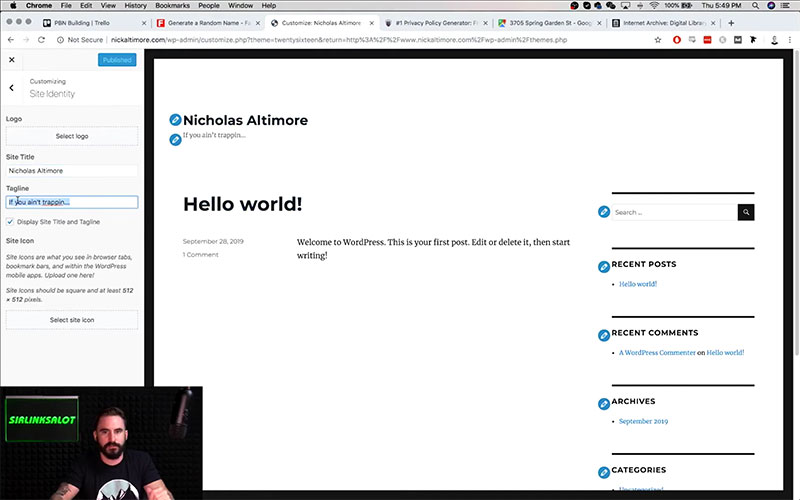
The next thing we want to do is go over to permalinks. You’re going to find that under settings -> permalinks. You’ll see that there are quite a few different options. The one you want to choose when you’re first getting into PBN building is just this – post name.
For the beginning stages, this is the way you want to keep it. It will just make your life a whole lot easier, and it’s going to help with relevance within the permalink structure and then transcending to whatever money site you’re trying to send power to.
After that, you’re going to want to create a logo or a favicon. Logomaker.com is one of my favorites because it’s super simple. You just type in whatever you want and they give you different ideas. You can use them as a favicon and as a site logo, or you can make two different ones.
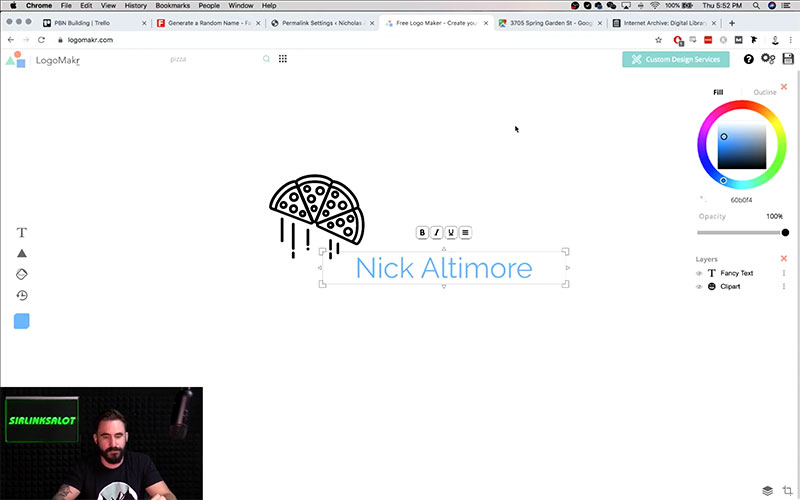
For a paid (but cheap) option, you can check out graphically.io. They give unlimited tweaks and mockups for your projects and offer a much higher level of customization for someone who wants it.
Then, you can use something like canva.com to create a quality header. Canva gives you a lot of really nice options as far as professional-looking designs for headers of all styles, email templates, etc. It’s also free and is a great option when it comes to PBN building.
Next, you want to disable your emails and turn off commenting. To do that, go to settings -> discussion. You want to go through the options and remove anything that allows somebody to spam your PBN with a bunch of junk comments.
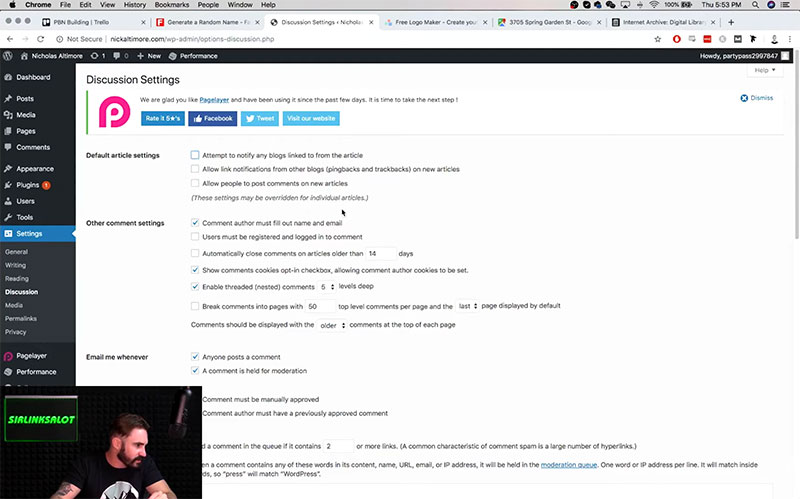
After you’ve done that, go ahead and adjust your widgets as well. You can find this under appearance -> widgets. This is where you can adjust what shows up on the sidebar. Leaving these the same all the time can create a footprint, so you’re going to want to adjust these things so that they’re unique to each PBN.
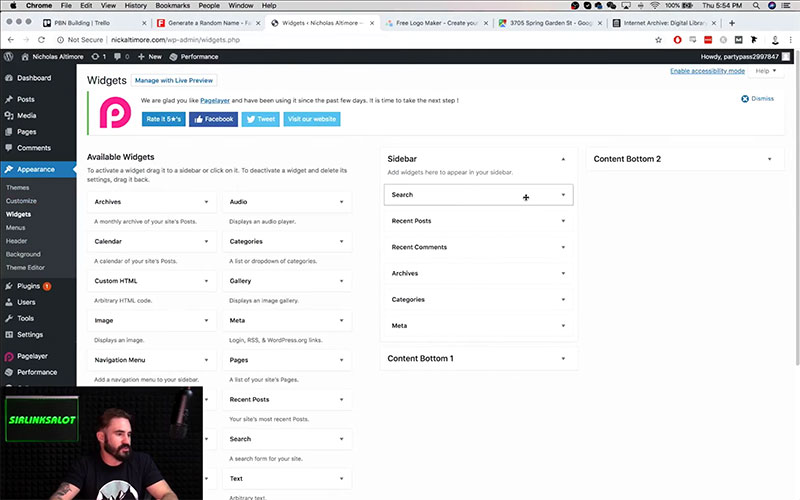
If you’d like, another thing you can do is add banners to make things look a bit more real. You can go to moat.com and get all kinds of free banners.
That’s about it for design and details. Again, just like a real site, you can always modify it as much as you’d like. People usually just build PBNs as quickly as possible so they can start generating power for another site. Because of this, they typically keep things very minimal when it comes to design.
Plugin Diversification
Diversification is a very, very important part of building a PBN.
One of the biggest footprints that happen when building PBNs, especially for newer people, is that they use the same plugins or too many similar plugins.
Google’s algorithm doesn’t need a manual review to note that all the PBNs pointed to one money site all have the same plugins or a vast majority of the same plugins. It’s a red flag, and it’s going to get you popped.
So, you need to use plugins to diversify as well as get things situated properly within the site. We have some ideas for you here, but it’s never-ending when it comes to finding new plugins to use and how well you can diversify a PBN.
One of the big ones is SEO plugins. We’re all familiar with Yoast, Rank Math, etc. But if you type in “SEO” in the plugins section, you’ll see that there is a multitude of options to pick from. One of the main things you’re going to be doing with these plugins is adjusting things like permalink structure, etc.
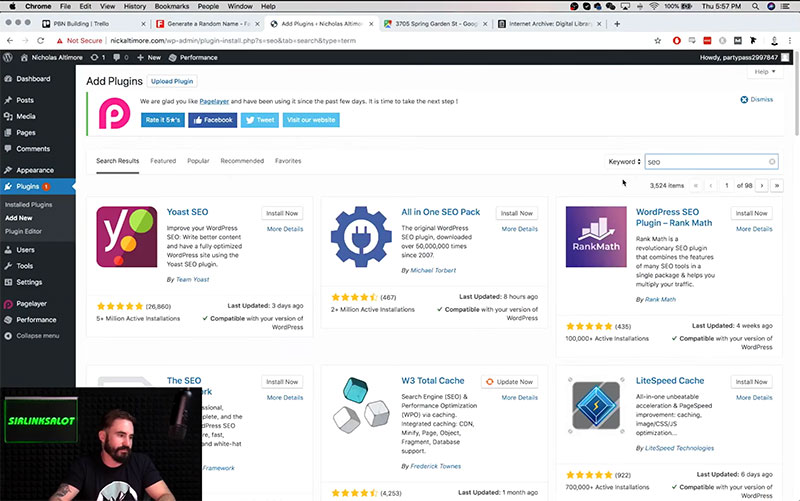
Next up is your sitemap. Be sure that the sitemap plugin does not interact negatively with the SEO plugin (WordPress will give you a warning if it does). Yoast, for example, has its own site map, so make sure they don’t cause any issues with each other.
Then, you’re going to want something like a caching plugin. So type that in, and a bunch are going to pop up. And you can use any of these to diversify. You’re going to want to use a caching plug-in on all your PBNs. There’s plenty to choose from so diversifying shouldn’t be an issue here.
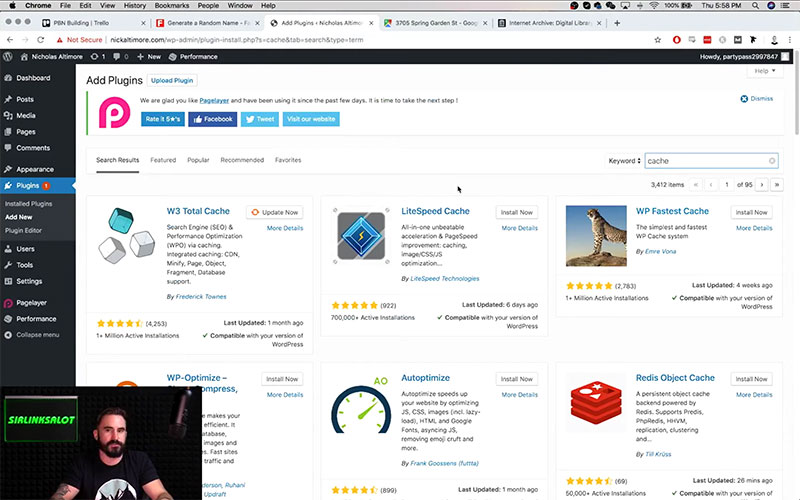
A spam plugin is always useful because PBNs don’t get monitored all that well for most people. Beginners might ignore certain things that go on, and before they know it their site’s been hacked and somebody else has been using and abusing it.
Other plugins you might use are things like related posts. It’s going to show other posts that are relatable to the one that you just put up.
Be very careful about using redirect plugins as even if you use a hundred different plugins that are redirecting everything to the home page across a hundred different sites, that’s still a big footprint. Just use them sparingly and on PBNs that have a lot of inner-page juice that you most certainly want to save.
There are non-stop plugins that can be used for your PBN. I like to always add a couple of random plugins as well that are just related to that particular PBN.
Let’s say I was making a website about cars. Type in “car” in the plugins section. You don’t actually have to use whatever you find, but you’re diversifying what plugins are active on this site and that is something that Google can crawl and see.
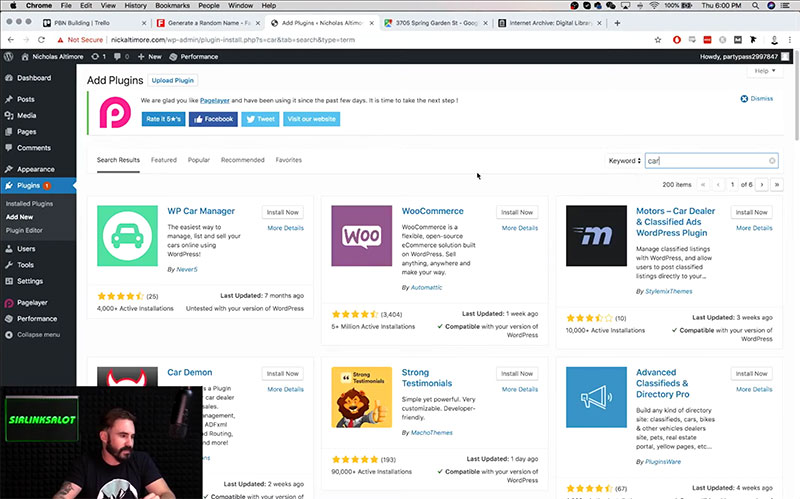
I highly recomend doing this!
Putting Your PBN to Use
Now it’s time to get ready to use your PBN.
Again, you can adjust things to make it look more real, add a bunch of content, etc. But don’t over-think the use of this PBN, don’t send a brand new PBN right away, and if you’re not very familiar with PBN use – move slowly.
Pay attention to your variables and make sure that you’re doing things in a scientific manner. That way you understand what you’re doing, and with that, you’re going to be able to scale this more and use it to influence your sites more efficiently and effectively.
You should always be thinking, “What is natural for a website to do?”
Mix things up. For example, take outbound links. Don’t just hit the same URL every single time from 15-20 different PBNs and that’s it. Sprinkle some inner linking into your articles in the same way any other website would do.
Images, videos, and word count should also change between your PBNs and posts. Be knowledgeable of the fact that naturally within a site, a post might go up with no links. A post might go up with a couple of links, some authority outbound links, etc.
Think about what might look natural. And if you get worried about that, all you have to do is type things into Google and find real sites to look at. Try to emulate what looks natural as best you can, and that’s going to help your PBN have longevity and continue to pass power.
PBN Building Checklist Wrap-Up
Overall, this is a basic outline you can use as a template to build a PBN. Available for free download below, we have a more concise PBN building checklist that you can pass over to VAs or use yourself.
I hope this helps! Leave any questions or comments below, or feel free to join the discussion at the SEO Round Table.
Watch the PBN Checklist Video:
 Article by:
Article by:
Nicholas Altimore
Hey I'm Nick, the Founder/Director here at SirLinksalot. I have a passion for building online businesses and taking websites to the next level with the help of my amazing link building team.
 Questions or Comments?
Questions or Comments?
We are active in our Facebook Group seven days a week and would love to hear from you. Ask us questions, learn from other group members, and share your knowledge.
Related Posts
Ready To Start Building Your Rankings?
Your link building journey to the top of Google starts today!
Apply for Managed Link Building to get a free analysis and game plan, or order backlinks a la carte.
Link building services that work.


